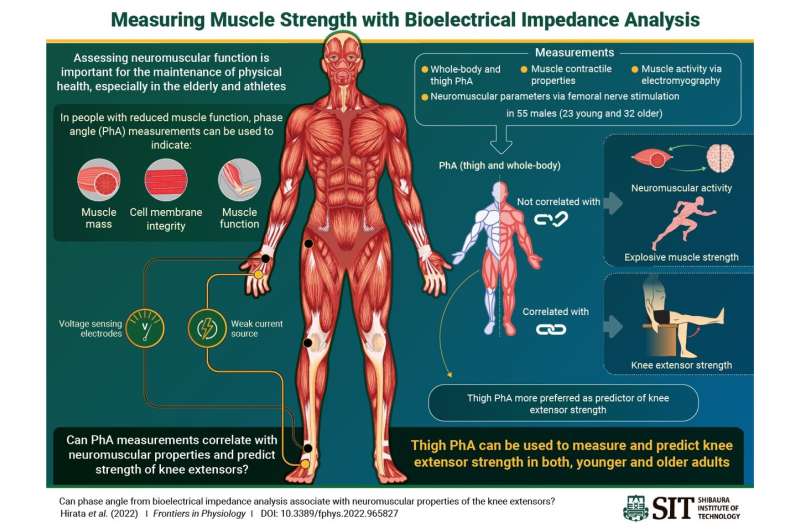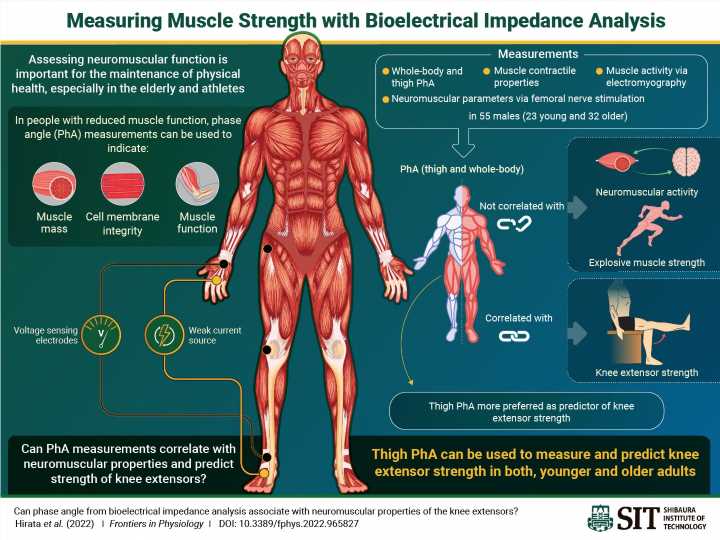
Muscular strength and its improvement are important to everyone for their regular day-to-day life activities. Conventionally, muscle function can be assessed by means of physical performance tests and/or muscle strength measurements. However, these methods are not applicable to those who cannot undergo forceful muscle contractions like infants, the elderly, and patients with injuries or cognitive disorders (like dementia).
An easy and popular alternative is using bioelectric impedance analysis (BIA), which can quickly and non-invasively measure tissue resistance (which depends on the amount of water and electrolytes present in the tissue) and reactance (which depends on the integrity of the cell membrane).
Phase angle (PhA), a measurement derived via BIA, is calculated using the tissue’s resistance and reactance. It is directly proportional to muscle cell mass and function. Many studies have linked whole-body PhA with maximal muscle strength, but there are none associating PhA with knee extension strength or explosive muscle strength (which is the strength required to make quick, strong movements like sprinting or getting up from a chair) in adults.
Keeping in mind the importance of knee muscle strength—especially in the elderly, in whom it is necessary for their independence, and athletes, who require strong knees for better performance–such a study was necessary.
In this vein, a group of scientists including Professor Ryota Akagi, from the College of Systems Engineering and Science, Shibaura Institute of Technology (SIT); Assistant Professor Kosuke Hirata from the Faculty of Sport Sciences, Waseda University; and researchers Yosuke Yamada and Tsukasa Yoshida from the Section of Healthy Longevity Research, National Institute of Health and Nutrition, National Institutes of Biomedical Innovation, Health and Nutrition investigated the association of PhA with the neuromuscular properties of knee extensor muscles in both, young and older adults.
Their findings were published in Frontiers in Physiology. Dr. Akagi and Dr. Hirata, the corresponding authors of the article, say, “We aimed to assess the association of thigh PhA with maximal muscle strength, explosive muscle strength, contractile properties as well as neuromuscular activity, and find out which of the two—whole-body or thigh PhA–was a better predictor of knee extensor strength.”
The team measured the whole-body and thigh PhA of 55 participants (23 young males and 32 older males) at 50kHz. The participants were asked to perform 4-second maximal voluntary isometric contraction (MVIC) in order to measure peak torque (PTMVIC) and a 1-second MVIC to measure the rate of torque development (RTD) over a time gap of 0–200 milliseconds.
The mean average value of these three measurements (i.e., PTMVIC and RTD) was used for further analysis. Contractile properties were also analyzed as they are significant markers of the mechanisms underlying force generation in muscles. Lastly, muscle activity was assessed by electromyography (EMG-RMS).
The findings of the study revealed that both whole-body and thigh PhAs are associated with the muscle strength of knee extensors (with thigh PhA being the preferred predictor of knee extensor strength). However, this association was understood to be due to the muscles’ contractile properties rather than any neural aspects. Thus, both measurements could not predict neuromuscular activity or the explosive muscle strength (which largely depends on neuromuscular control) of knee extensors.
This study holds much promise for present and future implications. Speaking about the present, being able to assess knee muscle strength is very important, especially for the elderly (in whom strong knee muscles mean greater independence to move about), and athletes (who need to maintain knee muscle strength in order to perform better).
Source: Read Full Article
